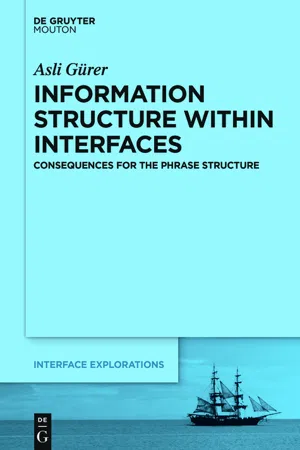1.1 Introduction
The investigation of information structural units has been a central issue in understanding the structure of grammar. Semantic, pragmatic, syntactic and prosodic factors are intertwined in the expression of information packaging, which in turn provides insight, not only, into the interfaces of these components, but also, into how diverse languages encode such information. The present work establishes a three-way classification for information structural units as (i) topic, which is further classified as aboutness topic and contrastive topic, (ii) focus, which is realized as discourse-new and contrastive focus and (iii) discourse anaphoric, given constituents. The investigation of information packaging becomes more complex but all the more intriguing, as some languages encode information structural units in several domains, use the same tools in the expression of further linguistic operations or do not mark them at all.
Gungbe (Aboh 2007), Chickasaw (Büring 2009), West Chadic languages Bole, Hausa and Tangale (Zimmerman 2011), Somali (Frascarelli 2012) mark focus with overt morphological markers. However, variation is observed even within a single language. In Gungbe, there is a difference between subject and object focus phrases in that in-situ object phrases are not marked overtly (1b).
(1) a. | Étɛ́ | wɛ̀ | Kòfí | ɖù? |
| what | FOC | Kofi | eat |
c. | Lɛ́sì | wɛ̀ | é | ɖù | (bò | bɛ́ | àwútù) |
| rice | FOC | 3SG | eat | and | start | sickness |
‘He ate rice (and became sick).’
(adapted from Aboh 2007: 291)
Some languages encode information structure through prosodic strategies. In English, the distinction between discourse-new constituents and contrastive focus is reflected in prosody in that contrastive focus has a higher pitch height and duration than discourse-new constituents (Katz and Selkirk 2011). In Italian, if a constituent in a sentence is marked with [F], it restructures and enlarges its phonological phrase but this is not the case in constructions with all-new sentences (Frascarelli 1997). In Japanese and German, focus and givenness have an effect on pitch register while syntactic structure has an effect on prosodic structure (Féry and Ishihara 2009). In Tangale, a phrase boundary is inserted before the focused phrase (Zimmerman 2011).
Syntactic reordering is another strategy used to mark information packaging. In Italian, shifting (aboutness), contrastive and familiar topic phrases surface in a sentence in this hierarchical order (Frascarelli and Hinterhölzl 2007). In Romanian, Catalan and Hungarian, the immediately preverbal position has been suggested to be the identificational, contrastive focus position (Kiss 1998).
(2) a. | Tegnap | este | Marinak | mutattam | be | Pétert. |
| last | night | Mary.DAT | introduced.I | PERF | Peter.ACC |
‘It was to Mary that I introduced Peter last night.’
b. | Tegnap | este | be | mutattam | Pétert | Marinak. |
‘Last night I introduced Peter to Mary.’
(adapted from Kiss 1998: 247)
In (2a), the preverbal dative marked constituent bears identificational focus in Hungarian. It is the sentence final position that is reserved for this purpose in Russian (Dyakonova 2009) and Spanish (Zubizarretta 1998) or sentence initial position in Finnish (Vallduví and Vilkuna 1998) and Hausa (Zimmermann 2011). In Bole, a Bantu language, focused subjects undergo movement to the postverbal position and in that case, morphological marking becomes optional (Zimmermann 2011).
A language can also use mixed strategies and encode the information status of the constituent in different domains ...
